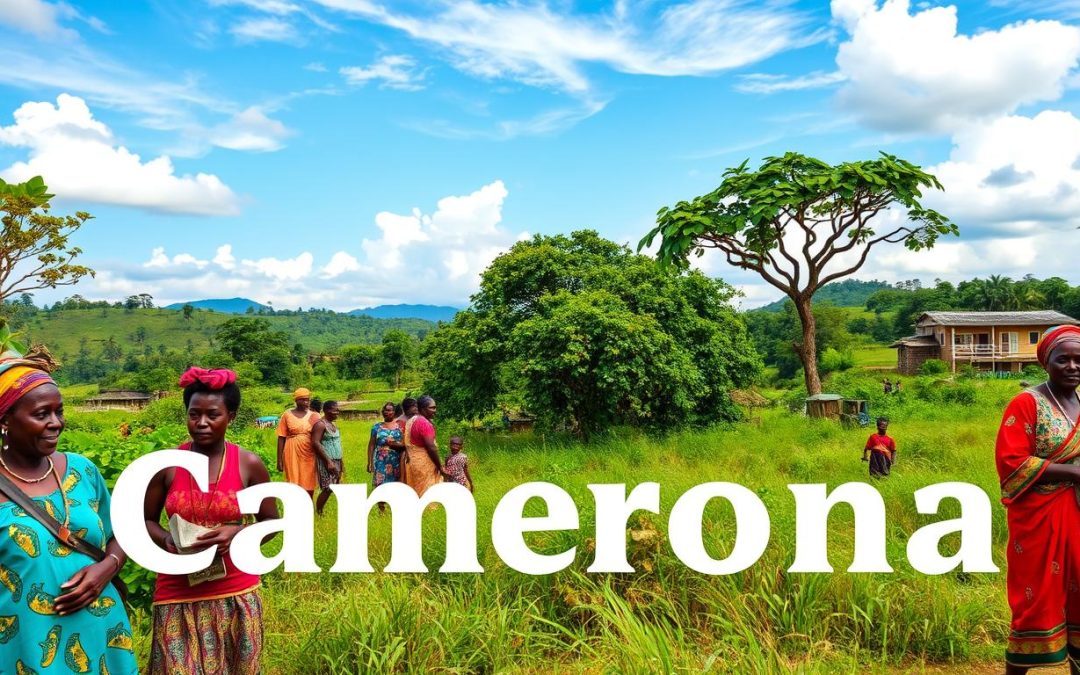Have you ever wondered how a country can thrive with over 250 languages coexisting in one vibrant nation? Welcome to Cameroon, a linguistic marvel where French and English dance together in perfect harmony.
Cameroon is a unique place where two colonial languages, French and English, are official. Over 80% of Cameroonians speak French, and about 25% speak English. This makes Cameroon a special place with a rich language mix.
Despite the complexity of its languages, Cameroon has turned it into a strength. The country is dedicated to bilingualism. This is shown in its schools and universities, where both French and English are taught.
Key Takeaways
- Cameroon has two official languages: French and English
- Over 250 languages are spoken across the country
- 83% of the population is Francophone
- 17% of the population is Anglophone
- Bilingualism is a core national characteristic
- Language diversity reflects rich cultural heritage
Introduction to Cameroon’s Linguistic Landscape
Explore the amazing world of Cameroon, known for its incredible language variety. Over 250 languages are spoken here, making it a treasure for linguists and culture lovers.
The language scene in Cameroon is complex. It’s made up of many language families and historical influences. Each language shows a unique part of Cameroon’s rich heritage.
Overview of Language Diversity
Cameroon’s language world is incredibly rich. It includes a wide range of language groups:
- 55 Afro-Asiatic languages
- 2 Nilo-Saharan languages
- 4 Ubangian languages
- 169 Niger–Congo languages
Historical Context of Language Development
The language diversity in Cameroon comes from long migrations, cultural exchanges, and complex history. French and English colonial legacies also shaped the language scene.
Current Language Statistics
| Language Category | Percentage |
|---|---|
| French Speakers | 30% |
| English Speakers | 10% |
| Indigenous Language Speakers | 60% |
Yaoundé, the capital, shows this language complexity. You see multilingual signs and lively language interactions everywhere, showing the nation’s rich communication.
Cameroon’s languages are not just communication tools, but living repositories of cultural memory and identity.
French and English: The Official Languages of Cameroon
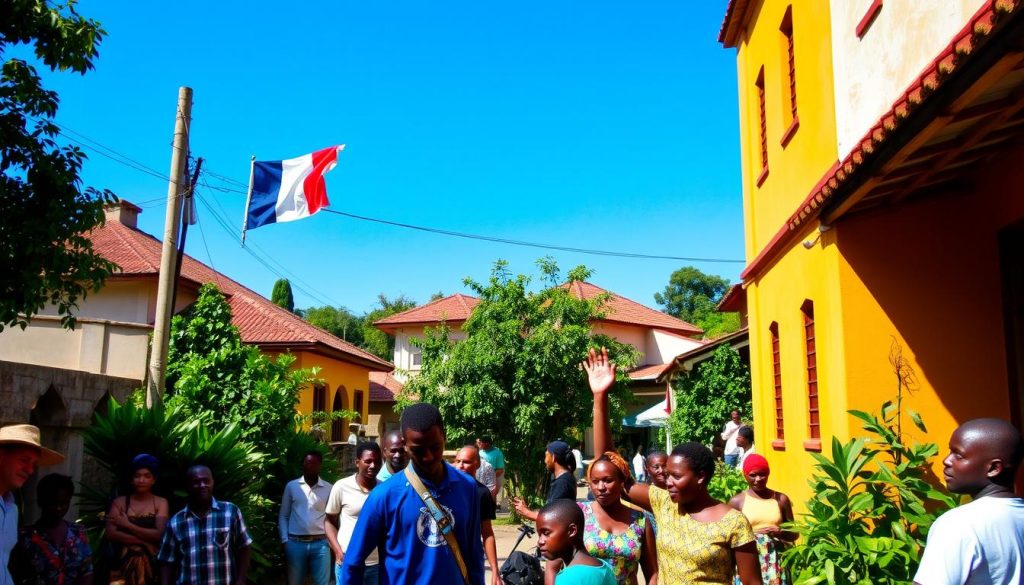
Cameroon has two official languages: French and English. This choice reflects the country’s complex past and its current identity. The country is divided into eight francophone and two anglophone regions. This division shows how cultures blend together.
The way people speak in Cameroon is quite interesting:
- About 70% of Cameroonians speak French.
- Around 30% speak English.
- In 2024, 11.957 million people will speak French.
Over the years, more people have learned to read and write:
| Language | Literacy Rate 1987 | Literacy Rate 2005 |
|---|---|---|
| French | 41.3% | 57.6% |
| English | 13.4% | 25.3% |
Interestingly, about 11.6% of Cameroonians are bilingual, showing the nation’s language flexibility. These languages are key in government, schools, and media. They connect different communities.
“Language is the roadmap of a culture. It tells you where its people come from and where they are going.” – Rita Mae Brown
Cameroon’s bilingual system is a strong example of diversity and unity.
Cameroon: Official and widely spoken languages
Cameroon is a linguistic wonder, with 309 languages spoken across the nation. This diversity reflects the country’s rich cultural heritage. It attracts linguists and cultural enthusiasts from around the world.
The country’s language journey focuses on French and English, its two official languages. These languages have deep roots, shaped by Cameroon’s colonial past under French and British rule.
French Language Usage and Distribution
French is the dominant language in Cameroon, spoken by about 83% of the population. It’s common in 8 out of 10 regions, making it widely understood.
- 83% of Cameroonians speak French as their primary language
- 57.6% of the population demonstrates French literacy
- 46% speak French exclusively
English Language Usage and Regional Differences
English is less common but still important in Cameroon. About 17% of the population speaks English as their primary language. This is mainly in two anglophone regions.
- 17% of Cameroonians speak English as their primary language
- 25.2% of the population shows English literacy
- 13.6% speak English exclusively
Bilingualism Challenges and Opportunities
Bilingualism in Cameroon is both challenging and full of opportunities. Only 11.6% of the population is literate in both French and English. This shows the complexity of language learning in the country.
“Language is the road map of a culture. It tells you where its people come from and where they are going.” – Rita Mae Brown
| Language Proficiency | Percentage | Number of People |
|---|---|---|
| French Only | 46.0% | 5,112,479 |
| English Only | 13.6% | 1,509,292 |
| French and English | 11.6% | 1,293,502 |
| Neither French nor English | 28.8% | 3,199,221 |
Camfranglais, a mix of French, English, and local languages, shows the creativity of Cameroonian youth. It’s a way for them to navigate their multilingual world.
Indigenous Languages and Their Cultural Significance
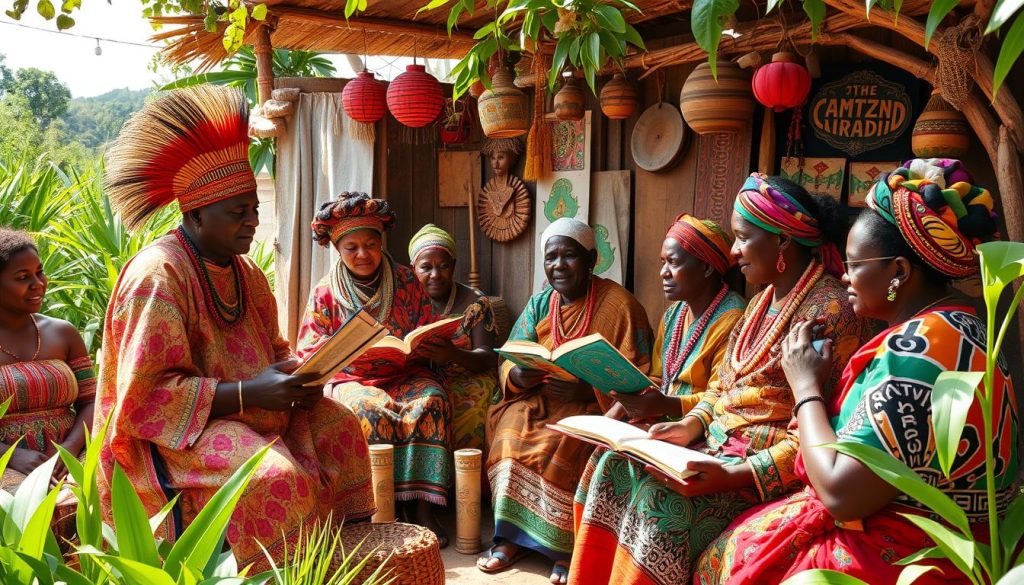
Cameroon is home to a wide range of languages, showing its rich culture. With 277 indigenous languages, these languages are more than just a way to talk. They hold deep cultural value and traditional knowledge.
These languages are key to community identity and unity. Each one tells stories, traditions, and views of the world. Sadly, about four percent of these languages have vanished since 1950.
“Languages are the roadmaps of a culture. They tell you where its people come from and where they are going.” – Rita Mae Brown
Many groups are working to save these languages. The UNESCO Strategy for Youth and Adult Literacy (2020-2025) wants to protect and celebrate these languages.
Linguistic Diversity Breakdown
- Total indigenous languages: 277
- Languages at risk of extinction: 4 (Duli, Gey, Nagumi, and Yeni)
- Dominant language family: Niger-Kordofanian
Preservation Efforts
| Organization | Focus | Years of Work |
|---|---|---|
| Summer Institute of Linguistics (SIL) | Language Development | Over 50 years |
| UNESCO | Literacy and Language Preservation | Ongoing |
By supporting these languages, you help keep Cameroon’s cultural stories alive. This makes its language landscape truly special.
Major Native Languages: Ewondo, Bassa, and Duala
Cameroon is home to a wide range of languages, showing its rich culture. Ewondo, Bassa, and Duala are key languages that show the local way of talking and cultural identity.
The language scene in Cameroon is lively and complex. Even though the country has two official languages, native tongues are vital for keeping traditions alive and helping locals talk to each other.
Ewondo Language and Its Speakers
Ewondo is a Bantu language spoken by over half a million people. It’s mainly found in the Center, South, and East provinces. Ewondo acts as a bridge for local communities.
- Spoken primarily in central Cameroon
- Estimated 500,000+ speakers
- Key to cultural preservation in rural regions
Bassa Language Communities
The Bassa language connects about 300,000 Cameroonians to their past. It’s more than a way to talk; it’s a link to history and local identity.
- Approximately 300,000 native speakers
- Integral to community communication
- Represents rich cultural heritage
Duala Language Impact
Duala is mainly spoken in Douala, Cameroon’s biggest city. The Duala and Mungo people use it for cultural expression and everyday talk.
“Language is the road map of a culture. It tells you where its people come from and where they are going.” – Rita Mae Brown
Ewondo, Bassa, and Duala are more than just ways to talk. They are living parts of Cameroon’s diverse culture. They connect people across generations and keep local identities unique.
The Rise of Cameroonian Pidgin English (Kamtok)
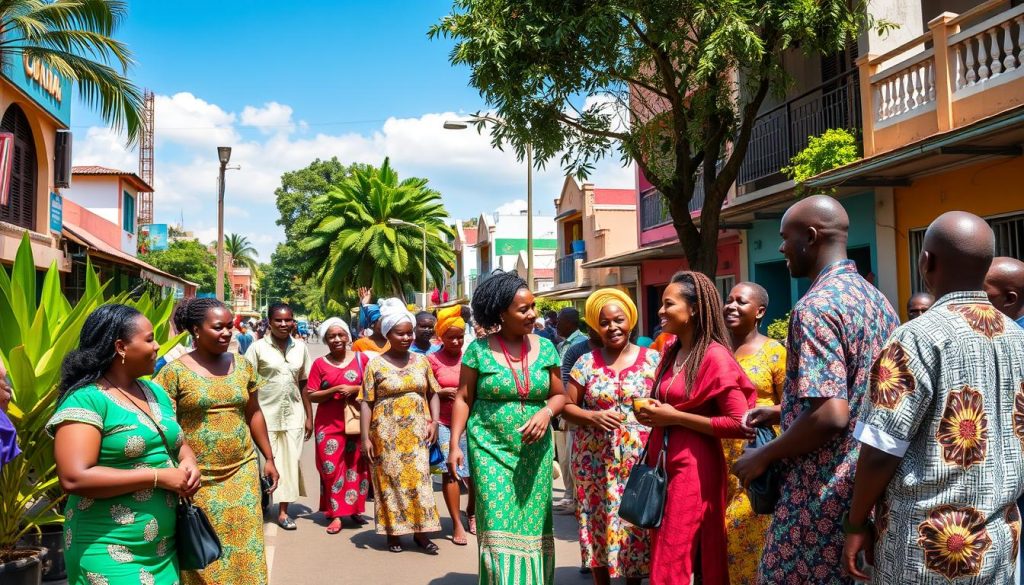
Imagine a language that connects people across diverse communities in Cameroon. Cameroonian Pidgin English, or Kamtok, does exactly that. It has about 12 million speakers as of 2017. This vibrant language has become a key way to communicate across the country.
Kamtok started during the Slave Trade Years, from 1440 to the early 1800s. It has deep roots in Cameroon’s complex language scene. Even though only 5% speak it as their first language, 50% use Kamtok in some way.
“Kamtok is more than a language; it’s a bridge between cultures and communities.” – Linguistic Researcher
The language has five major types:
- Grafi Kamtok
- Liturgical Kamtok
- Francophone Kamtok
- Limbe Kamtok
- Bororo Kamtok
Kamtok is linguistically interesting. It has:
- Six unique vowel phonemes
- 21 distinctive consonant phonemes
- Ability to form complex consonant clusters
- Borrowings from indigenous Cameroonian languages
Kamtok goes beyond Cameroon’s borders. It connects people in diaspora communities in France, the UK, Germany, the USA, and South Africa. It acts as a unifying language, helping to bridge communication gaps in this multilingual nation.
Fulfulde: The Lingua Franca of Northern Cameroon
Explore the language that ties communities in Northern Cameroon together. Fulfulde is a powerful tool for communication, linking different ethnic groups through its rich history.
Geographic Distribution of Fulfulde
Fulfulde covers a vast area in Northern Cameroon. It has about 12 million speakers, making it a key language in many regions. It also reaches beyond Cameroon, connecting people in:
- Far North region of Cameroon
- Northeastern Nigeria
- Parts of West and Central Africa
Cultural Significance
Fulfulde holds deep cultural value. It’s not just a language; it’s a symbol of identity for the Fulani people. Many communities choose Fulfulde for its high status and influence.
| Language Statistic | Details |
|---|---|
| First Language Speakers | 37 million |
| Second Language Speakers | 2.7 million |
| Countries with Official Status | 9 countries |
Communication Role
In Northern Cameroon, Fulfulde goes beyond language. It helps with trade, socializing, and sharing news among various groups. It’s used in public spaces, community talks, and even on the radio.
“Fulfulde is not just a language, it’s a bridge connecting cultures and people” – Linguistic Researcher
Despite its growing importance, Fulfulde faces a challenge. Young people are switching to Fulfulde, which might lead to a loss of local languages. This could harm the area’s linguistic diversity.
Language Education and Policy in Cameroon
Cameroon is a special place where languages and education meet in complex ways. The country aims to be bilingual, which brings both challenges and chances for growth in education.
The government has set up several plans to handle the language diversity in schools:
- Promoting bilingual schools with separate anglophone and francophone sections
- Recognizing both English and French as official languages
- Creating the National Languages Department in 2008
But, there are still big hurdles to overcome in language education. Studies show that:
- Only a small number of Cameroonians can speak both official languages well
- Most teachers find it hard to include language diversity in their lessons
- School leaders often focus more on official languages than national ones
“The failure to implement mother-tongue instruction denies students the opportunity to express their linguistic identity.”
The 1995 Education Forum dreamed of a trilingual citizenry – speaking French, English, and at least one national language. The 1996 constitution recognized the importance of national languages, but making it happen has been tough.
| Language Policy Aspect | Current Status |
|---|---|
| Official Languages | English and French |
| Indigenous Languages | Approximately 300 languages |
| Bilingual Education Goal | Partial implementation |
Understanding Cameroon’s language education shows a careful balance. It tries to meet official language needs while keeping cultural languages alive.
Endangered Languages and Preservation Efforts
Cameroon’s language heritage is at risk of disappearing. Over 70 languages in the grassfields region are endangered. Many indigenous languages are on the verge of extinction.
Several factors threaten Cameroon’s endangered languages. These include:
- Dominance of English and French in schools
- Urbanization making traditional languages less common
- Economic opportunities favoring dominant languages
- Less language passed down from one generation to the next
Current Threats to Indigenous Languages
Statistics show a worrying trend. Since 1950, 4% of Cameroon’s languages have become extinct. Languages like Babanki and Njerep are especially vulnerable. Njerep is now spoken by just 4 people.
“Language is the roadmap of a culture. It tells you where its people come from and where they are going.” – Rita Mae Brown
Conservation Initiatives
But, there’s hope. New efforts aim to save endangered languages. Community projects use technology and grassroots methods to document and revitalize languages:
- Starting bilingual education programs
- Creating digital archives of language resources
- Developing online language learning platforms
- Hosting community language workshops
Supporting these efforts can help preserve Cameroon’s linguistic diversity. This way, future generations can still enjoy its rich language heritage.
Modern Language Trends: Camfranglais and Urban Communication
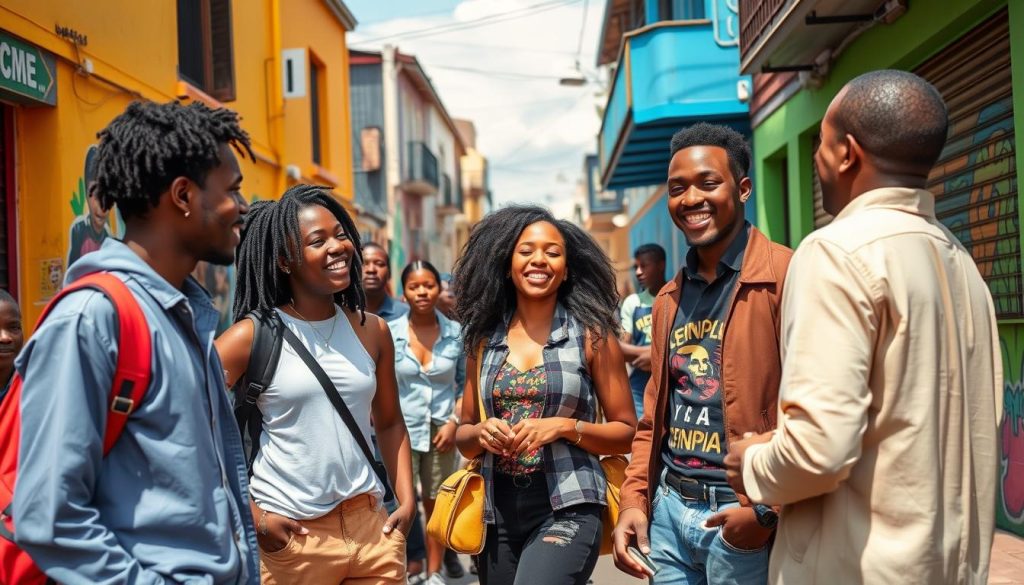
Camfranglais is a unique language from Cameroon’s cities. It mixes French, English, and local words. This blend is popular among young city folks.
Camfranglais shows how diverse languages are in Cameroon. Young people use it to:
- Navigate multiple language backgrounds
- Express cultural identity
- Create social connection
- Challenge traditional language boundaries
Studies give us interesting facts about Camfranglais:
| Urban Communication Metric | Percentage |
|---|---|
| Youth using Camfranglais | 70% |
| Lexical borrowing from regional languages | 40% |
| Code-switching in bilingual conversations | 60% |
Camfranglais is more than a language – it’s a cultural expression. Cities like Yaoundé and Douala are where it thrives.
“Camfranglais represents the creative linguistic spirit of Cameroonian youth” – Contemporary Linguistics Research
Learning about Camfranglais helps us see how language changes. It shows how language adapts to social and cultural needs.
German Language Legacy in Contemporary Cameroon
The German language has a special place in Cameroon’s history. It comes from the country’s colonial past. Even though French and English are more common, German still has a role in Cameroon’s language scene.
When Germany ruled Cameroon briefly, the language deeply influenced the culture. Now, about 300,000 Cameroonians study or speak German. This makes Cameroon one of the biggest German-speaking countries in Africa.
“Language is the road map of a culture. It tells you where its people come from and where they are going.” – Rita Mae Brown
The German language’s lasting impact in Cameroon brings benefits:
- More chances for education abroad
- More job opportunities worldwide
- A link to European academic and professional circles
In Cameroon, many schools and universities teach German. This shows the country’s rich language heritage. Students see learning German as a way to get scholarships and jobs globally.
German Language Learning in Cameroon
| Learning Category | Percentage |
|---|---|
| School-based German Learners | 65% |
| University German Programs | 25% |
| Professional Language Courses | 10% |
The German language’s legacy in Cameroon shows how colonial pasts can lead to cultural and educational benefits. It connects past and present through language.
Conclusion
Cameroon is a true marvel of linguistic diversity, with about 300 languages spoken there. Exploring the country’s language scene opens up a world where talking goes beyond usual limits. Each language is a key to understanding local customs and social life.
In places like Lower Fungom, language is more than just talking—it’s essential for survival. People there often speak five or six languages, thanks to family and community ties. This shows how knowing many languages can help people get what they need and stay safe.
Even as English and Spanish become more common worldwide, Cameroon’s native tongues are vital. With 273 local languages, the country shows the value of keeping language heritage alive. This highlights the need to balance global trends with local traditions.
Thinking about Cameroon’s language journey reminds us that each tongue tells a story of history, identity, and connection. The country’s effort to keep its languages alive is a beacon for preserving culture in our global world.
The above is subject to change.
Check back often to TRAVEL.COM for the latest travel tips and deals.
Here are some Tours & Sightseeing suggestions that might pique your interests!
